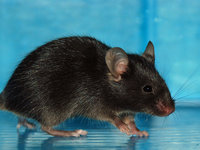Strain Data Sheet
RBRC02340
Strain Information | |
|---|---|
| Image |  |
| BRC No. | RBRC02340 |
| Type | Transgene |
| Species | Mus musculus |
| Strain name | C57BL/6-Tg(bitetO-GFP)BYoko |
| Former Common name | bitetO-GFP |
| H-2 Haplotype | |
| ES Cell line | |
| Background strain | C57BL/6JJcl |
| Appearance | black [a/a B/B C/C] |
| Strain development | Developed by Dr. Mineto Yokoi, Columbia University in 2002. The transgene was injected into the pronuclei of C57BL/6 fertilized eggs. |
| Strain description | This transgenic mice express a bitetO-GFP contained the bidirectional tetracycline operator (tetO) promoter driving EGFP and a rabbit beta-globin intron/polyA signal in one direction, and in the opposite direction, driving an artifical intron, an artificial fusion gene consisting of a placental alkaline phosphatase fragment, tetanus toxin C fragment, tyrosine phosphatase delta fragment, and glutamate receptor 2 fragment (RT8) and an SV40 polyadenylation signal. This strain can be used to make an inducible expression of EGFP crossing with the genetically-engineered mice that have a tetracycline-controlled transactivator (tTA). |
| Colony maintenance | Carrier x Noncarrier [C57BL/6JJcl]Tg/+ hemizygous mice are viable and fertile. |
| References | Striatal medium spiny neurons terminate in a distinct region in the lateral hypothalamic area and do not directly innervate orexin/hypocretin- or melanin-concentrating hormone-containing neurons. Sano H, Yokoi M J. Neurosci., 27, 6948-6955 (2007) 17596443 |
Health Report | |
|---|---|
| Examination Date / Room / Rack | |
Gene | |||||||
|---|---|---|---|---|---|---|---|
| Gene Symbol | Gene Name | Chr. | Allele Symbol | Allele Name | Common Names | Promoter | Diseases Related to This Gene |
| GFP | Green Fluorescent Protein (Aequorea victoria) | UN | E. coli tetO (tetracycline operator) | ||||
| Gria2 | glutamate receptor, ionotropic, AMPA2 (alpha 2) | UN | Gria2 | ||||
| HBB2 | rabbit beta-globin intron/polyA signal | UN | HBB2 | ||||
| PLAP | human placental alkaline phosphatase | UN | PLAP | ||||
| Ptprd MGI:97812 | protein tyrosine phosphatase, receptor type, D | UN | Ptprd | ||||
| TTC | non-toxic c fragment (Clostridium tetani) | UN | TTC | ||||
| poly A | SV40 polyA signal | UN | poly A | ||||
Phenotype | |
|---|---|
| Annotation by Mammalian phenotyhpe ontology | |
| Detailed phenotype data | |
Ordering Information | |
|---|---|
| Donor DNA | E. coli tetO, CMV minimal promoter, Aequoria Victoria GFP cDNA, Rabbit beta-Globin intron/polyA signal, Human placental alkaline phosphatase, Clostridium tetani Non-toxic c fragment, Mouse tyrosine phosphatase δ(fragment), Mouse glutamate receptor 2 (fragment), SV40 polyA signal |
| Research application | Fluorescent Proteins/lacZ System Neurobiology Research Tet system |
| Specific Term and Conditions | In publishing the research results obtained by use of the BIOLOGICAL RESOURCE, a citation of the following literature(s) designated by the DEPOSITOR is requested. J. Neurosci., 27, 6948-6955 (2007). RECIPIENT may only use the BIOLOGICAL RESOURCE for non-commercial academic research purpose. |
| Depositor | Yokoi Mineto (Kyoto University) |
| Strain Status |  Frozen embryos Frozen embryos Frozen sperm Frozen sperm |
| Strain Availability | Recovered litters from cryopreserved embryos (2 to 4 months) Cryopreserved sperm (within 1 month) Cryopreserved embryos (within 1 month) |
| Additional Info. | Necessary documents for ordering:
Genotyping protocol -PCR- |
BRC mice in Publications |
|---|
Yamada M, Suzuki Y, Nagasaki SC, Okuno H, Imayoshi I. Light Control of the Tet Gene Expression System in Mammalian Cells. Cell Rep 25(2) 487-500.e6(2018) 30304687 |